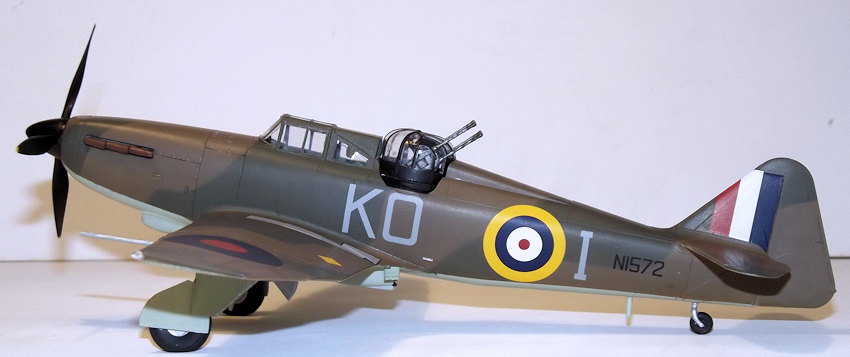
Airfix 1/48 Defiant I
| KIT #: | A05128 |
| PRICE: | £18-99 SRP |
| DECALS: | Two options |
| REVIEWER: | Frank Reynolds |
| NOTES: | New tool kit (2016) |

| HISTORY |
The Boulton Paul Defiant was
manufactured in response to a British specification drawn up in 1935 for a
fighter having its entire armament contained in a power driven turret. The
Hawker Aircraft Company and Boulton Paul responded to the request, but the only
design to go into production was the latter. It met the specification well and
the self-contained turret was a good engineering solution. The problems lay in
the flawed concept of the original specification, which anticipated that enemy
air fleets would obliging cruise along while Defiants penetrated their
formations with a concentrated broadside of gunfire, or attacked from below. The
Defiant was powered by a Rolls Royce Merlin II engine of 1,030 hp. This engine
was perfectly adequate for a contemporary single engine fighter of the period
but the aircraft was inevitably hampered by
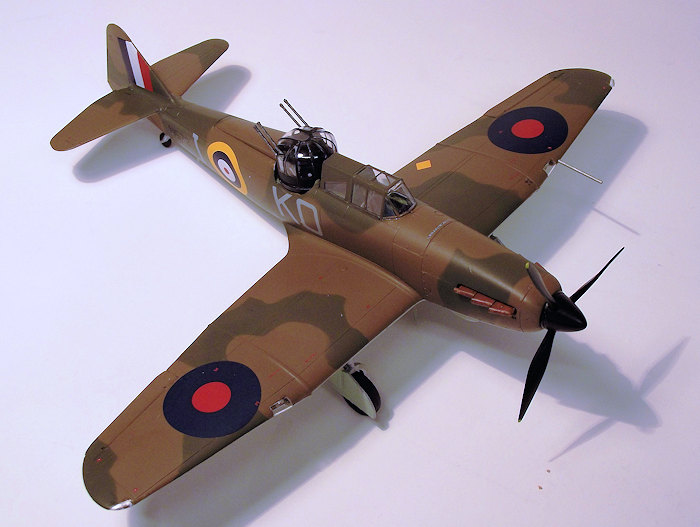 the weight and drag of the turret
and its second crew man. Contemporary reports suggest that the RAF looked to
post aircrew of significantly small stature to occupy the cramped turrets.
the weight and drag of the turret
and its second crew man. Contemporary reports suggest that the RAF looked to
post aircrew of significantly small stature to occupy the cramped turrets.
With the pilot having no forward firing guns, it proved difficult to position the aircraft in attack to give the gunner the best chance of an accurate shot. The Defiant was slower than a typical single seat fighter of the period by 80-100mph. Nevertheless, with war looming, the British put all that was available into production and the first of an initial batch of 85 came off the assembly line. This was five years after the specification was issued and the Defiant was required to face enemy forces that were considerably more sophisticated than those forecast in 1935. Defiants of No 264 Squadron RAF went into action from Manston, Kent, in 1940 covering the chaos of the British retreat from France and Belgium. The squadron claimed sixty five kills in one month when it became apparent that the Luftwaffe had mistaken Defiants for Hurricanes and attacked from the rear to be exposed to gunfire from the turrets. It transpired that the kills claimed had been greatly exaggerated in the confusion of combat. The enemy learned quickly and within days the Defiant squadrons were decimated and had to be withdrawn from daylight operations. By 31st August 1940, 120 aircraft had been delivered and over 60 had fallen to enemy fire.
Although Boulton Paul submitted a design for a single seat version with conventional wing mounted guns, there was no point since adequate numbers of Spitfires and Hurricanes were available. Over 300 Defiant Mk.1 fighters were built. The Defiant was converted to a night fighter role and later versions became target tugs.
The Defiant remains a curiosity of design and a flawed concept. It required great courage and dedication from its crews to go in harm’s way at a severe tactical disadvantage, but desperate times demanded it. Today the sole surviving Defiant is on display at the Royal Air Force Museum in Hendon, England.
| THE KIT |
The kit is supplied in Airfix’s now familiar bright red top opening tray type box. The instructions run to 16 pages of A4 half tone newsprint style with two full colour pages of camouflage and a stencil diagram. There are 71 stages of construction and the paint call outs are geared entirely to the Humbrol paint range, although the camouflage drawings have named colours.
The parts frames are bagged, four
moulded in Airfix’s standard medium density blue-grey plastic and one in clear.
The parts count exceeds 100. The smallish decal sheet offers two choices; both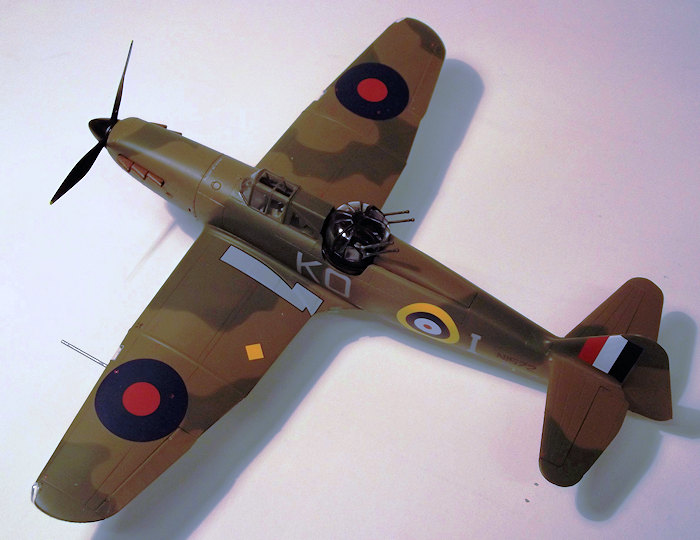 are variations of the RAF’s standard day fighter colours of 1940, being Dark
Green and Dark Earth upper surfaces with Sky underneath. The first depicts the
unlucky No. 264 Squadron, based at Martlesham Heath, Suffolk in July 1940 and
the second, No. 2 Squadron, Hatfield Woodhouse, Yorkshire, September 1940. The
decal sheet includes an instrument panel, wing walks and stencils. It is printed
with strong dense colours to Airfix’s usual good standard.
are variations of the RAF’s standard day fighter colours of 1940, being Dark
Green and Dark Earth upper surfaces with Sky underneath. The first depicts the
unlucky No. 264 Squadron, based at Martlesham Heath, Suffolk in July 1940 and
the second, No. 2 Squadron, Hatfield Woodhouse, Yorkshire, September 1940. The
decal sheet includes an instrument panel, wing walks and stencils. It is printed
with strong dense colours to Airfix’s usual good standard.
All parts appeared to crisply moulded with no sign of flash and little evidence of badly warped or twisted parts that have marred some of Airfix’s other recent releases, although one fuselage half had a slight twist and one small part short-shot. There is plenty of scope for options in the build since the kit has been cleverly designed to take account of its near-unique subject. The ailerons, elevators and rudder are separate parts that can be posed deflected. The radiator intake flap and crew step can be extended or retracted and the main gear fixed up or down, but requiring the purchase of a separately available display stand if the latter option is taken. However it is in the crew area that Airfix’s designers have excelled. The Defiant has distinctive fairings forward and aft of the gun turret, that retracted to enable the turret to be trained along the fuselage axis. In combination with the pilot’s cockpit hood being optionally open or closed, the turret can be mounted facing forward, aft, or on the beam with the fairings extended or retracted. But the clever part is an option to have an abeam –trained turret with an open back. An optional clear turret top has two separate petal-type windows that can be glued in place to simulate the outward sliding access doors. There are no less than eight clear parts devoted to these options.
The presence of flame damper exhausts and arrow head radar aerials on the parts frames gives a strong indication that a night fighter version may be released in due course.
| CONSTRUCTION |
This begins with the cockpit
interior which is well detailed. The pilot’s bucket seat is fixed to a bulkhead
with a pair of brackets and then to a curved floor section that follows the
shape of the wing centre section and runs from the engine bulkhead through to
the gun turret. A forward bulkhead is detailed with a large oil tank which,
according to the instructions, is meant to have a section of pipe projecting
from its underside. However my example was short shot and only a stump of
plastic remained. This was hardly a problem since the offending item was to be
buried in the front cockpit behind the rudder pedals, effectively unseen. The
cockpit interior was sprayed overall green using Tamiya Acrylic XF-71 Cockpit
Green with the pilot’s seat back padding picked out in Dark Brown. Two
ladder-type side frames provide detail to the cockpit
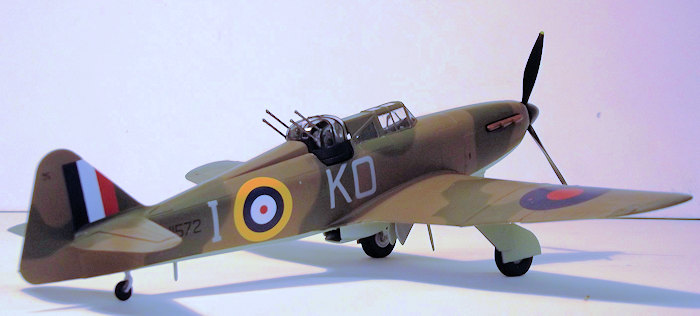 walls, giving an effective
representation of the rib structures and these are cleverly moulded to include a
representation of the throttle boxes and switch gear, which were picked out in
Flat Black. Some seat belts made from masking tape were added to the pilot’s
seat. The long interior assembly was glued into the left fuselage half, followed
by a one piece upper section that runs from the pilot’s head rest to the rear of
the gun turret. The instrument panel was painted flat black and finished with
the supplied decal that gives a convincing representation of the dials. This
component clicks onto a small ledge under the cockpit coaming. The right hand
fuselage half was glued up and, as with most Airfix kits lately, it is a very
snug fit. This is no serious criticism of well -engineered products, but even
the thickness of a coat of paint can throw things out of alignment. As it is,
the slightly warped fuselage half needed to be strapped down with masking tape
until the glue dried.
walls, giving an effective
representation of the rib structures and these are cleverly moulded to include a
representation of the throttle boxes and switch gear, which were picked out in
Flat Black. Some seat belts made from masking tape were added to the pilot’s
seat. The long interior assembly was glued into the left fuselage half, followed
by a one piece upper section that runs from the pilot’s head rest to the rear of
the gun turret. The instrument panel was painted flat black and finished with
the supplied decal that gives a convincing representation of the dials. This
component clicks onto a small ledge under the cockpit coaming. The right hand
fuselage half was glued up and, as with most Airfix kits lately, it is a very
snug fit. This is no serious criticism of well -engineered products, but even
the thickness of a coat of paint can throw things out of alignment. As it is,
the slightly warped fuselage half needed to be strapped down with masking tape
until the glue dried.
The wing is designed to be built up
as a one piece structure to be fitted under the fuselage. Three panels form the
lower surface and the centre section runs to the dihedral break points. A one
piece gear bay insert provides the walls and roof of the undercarriage bays. The
outer lower wing panels are secured across the dihedral break with angled box
structures that on another kit might be used to define the gun bays, except for
the fact that a Defiant has no wing guns, so they exist purely to strengthen the
joint and fix the outer wing panels to the correct dihedral. The upper outer
wing panels are in one piece from root to tip. Everything closed up neatly and
firmly and will fit just fine providing all of the
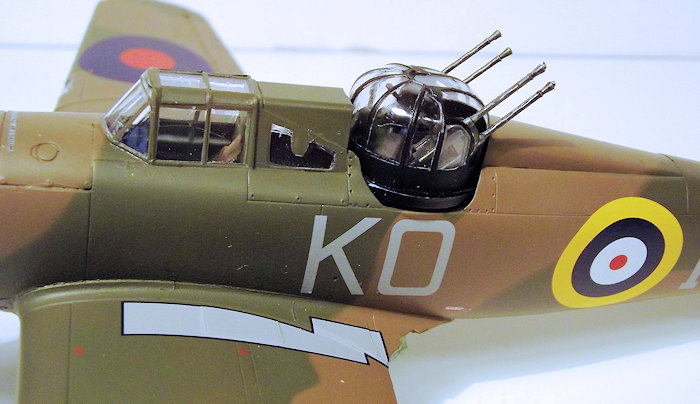 tiny mould tags are trimmed
away. The fuselage was glued down over the wing centre section, ailerons added
and the whole assembly set aside to harden overnight. Some filler was found to
be necessary along the long seam between the fuselage halves and once this was
rubbed down the tail assembly was added, together with the intakes under the
engine cowling and centre section.
tiny mould tags are trimmed
away. The fuselage was glued down over the wing centre section, ailerons added
and the whole assembly set aside to harden overnight. Some filler was found to
be necessary along the long seam between the fuselage halves and once this was
rubbed down the tail assembly was added, together with the intakes under the
engine cowling and centre section.
The gun turret can be treated as a sub assembly and the detailed interior is built up from sixteen parts. The structure comprises the turret ring, ammunition boxes, side support brackets for the guns, and a central pivot for the two pairs of twin Browning machine guns. The turret interior and exterior is painted Black, relieved only by the guns (Tamiya XF-56 Metallic Grey) and a brown seat (XF-64 Red Brown). About two thirds of the turret’s structure will be buried within the fuselage on completion, so little of the interior will be seen on the finished article. I took the opportunity to mask off the ten turret windows before assembly and spent a happy couple of hours juggling and trimming Tamiya tape onto the glazing, some panels of which are simultaneously curved and tapered. If some kind soul will produce some after- market pre -cut masks, it will not come too soon for me.
The turret assembly proved to be a very tight fit when attempting to slip the one piece glazing over the guns, once again highlighting that Airfix mould parts to very close tolerances and that even an over enthusiastic coat of paint can make life difficult. Eventually it was persuaded to close up after tiny amounts of plastic were shaved off the side of the gun breaches.
| COLORS & MARKINGS |
One everything had set the airframe
was buffed with an extra fine sanding stick, cockpit transparencies masked off
with Tamiya tape and the still open rear gunner’s section plugged with small
pieces of soft plastic sponge. The airframe was undercoated with Mid Grey Auto
primer from a rattle can and the undersides airbrushed in Xtracrylix XA 1007 RAF
Sky which, after overnight drying, was masked off before the upper surface base
coat of Xtracrylix XA 1002 Dark Earth was applied. After a further overnight
rest, the upper surface was masked out in a camouflage pattern, with rolled
snakes of Blu Tack low tack putty and Tamiya tape, to leave the exposed areas to
be airbrushed in Tamiya XF-81 RAF Dark Green. While painting was in progress the
undercarriage parts were sprayed in XF-16 Flat Aluminium and the outer faces
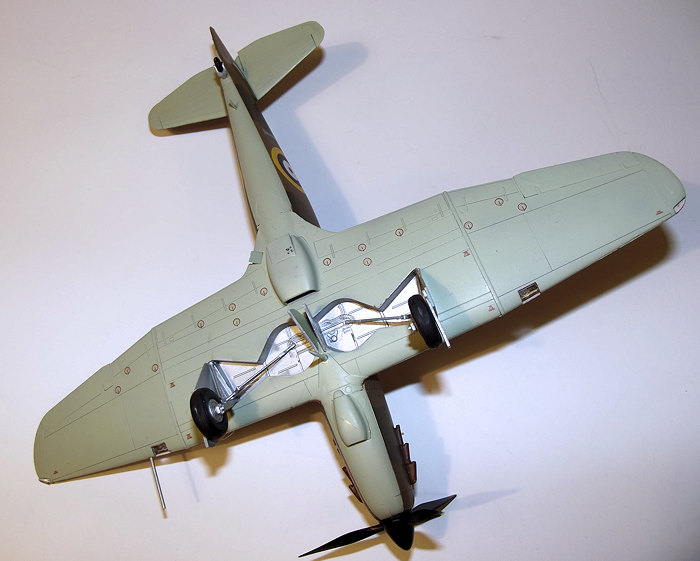 of
the gear doors in Sky. When all the paint had dried the airframe was given two
coats of brushed on Future/Klear as a base coat for the decals.
of
the gear doors in Sky. When all the paint had dried the airframe was given two
coats of brushed on Future/Klear as a base coat for the decals.
The decals seemed slightly thicker than those found in recent Airfix offerings and required a good soaking in warm water to get them to leave the backing paper. Once installed, they reacted well to Micro Set and Micro Sol and conformed to the inscribed surface detail.
The airframe was finished d with two misted coats of Xtracrylix flat varnish and the cockpit masking stripped away. Clear plastic lenses for the lights at the wing tips and leading edges were secured with Humbrol Clear Fix. The undercarriage components had been previously sprayed in XF-16 Flat Aluminium, so the wheel bays were brush painted on the same colour. Airfix have done a good job in engineering a sturdy undercarriage, the main legs being formed as one piece to include the large curved lower sections and the angled rear brace, the whole unit fitting positively into square sockets in the wheel bay. The large outer gear doors are formed as one piece and again lock positively onto the legs. Construction was completed by adding the centre gear doors, the large pitot tube to the wing leading edge and, in a counter–intuitive fashion, adding the aerial masts to the underside, where they keep the aerial clear of the arc of the turret. Finally the gun turret was eased into place, which required much fiddling and fettling since it was a very tight fit.
| CONCLUSIONS |
This is well up to Airfix’s latest standards. It is a kit that requires some care in assembly, so it is a little above the beginner’s category, but if the instructions are followed as recommended by the manufacturer there is every chance of a satisfactory result. It is the first mainstream kit of the subject in this scale so it should be welcomed and it makes an interesting comparison with Spitfires and Hurricanes of the period. Recommended by me and I am looking forward to a possible release of the rather more successful night fighter version.
| REFERENCES |
Warplanes of the Second World War, Volume 2, Fighters, by William Green. Macdonald & Co, 1961.
Profile No 117, Boulton Paul Defiant, Profile Publications Ltd, 1967
British Warplanes of World War 2, Aerospace Publishing Ltd 1998.
April 2016
Copyright ModelingMadness.com
Review kit courtesy of Spot on Models and Games of Swindon, England
If you would like your product reviewed fairly and fairly quickly, please contact the editor or see other details in the Note to Contributors.